A Report on Sun Safety and Skin Cancer in Australian Adults (PUB600)
VerifiedAdded on 2022/11/13
|19
|3753
|70
Report
AI Summary
This report investigates the relationship between sun safety practices and the incidence of skin cancer among Australian adults aged 25-35. The research employed a literature review and a questionnaire to assess sun safety behaviors, including the use of sunscreen, hats, clothing, and shade. The report analyzed the effectiveness of different sun protection methods, such as sunscreen and physical barriers, in preventing skin cancer. The findings highlight the importance of consistent sun safety measures and the need for increased awareness of the risks associated with sun exposure. The report also includes a detailed search strategy using databases like PubMed, CINAHL, and Medline, employing PICO framework and relevant keywords to identify pertinent research articles. The report concludes with a discussion on the benefits of sun safety practices, emphasizing the need for comprehensive strategies to minimize skin cancer risks in the target population.

SUN SAFETY AND SKIN CANCER 1
Sun Safety and Skin Cancer
STUDENT ID:
NAME:
Sun Safety and Skin Cancer
STUDENT ID:
NAME:
Paraphrase This Document
Need a fresh take? Get an instant paraphrase of this document with our AI Paraphraser
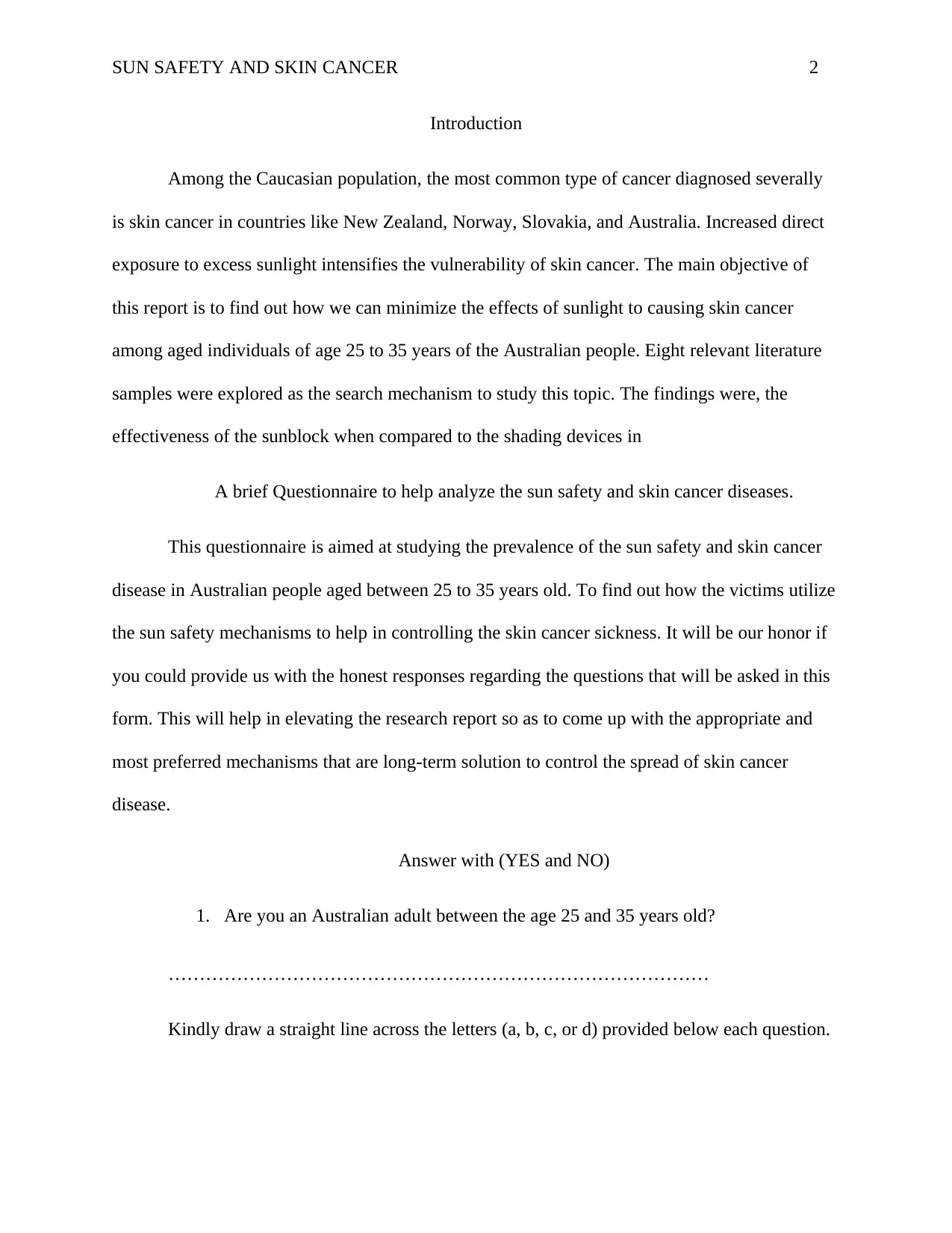
SUN SAFETY AND SKIN CANCER 2
Introduction
Among the Caucasian population, the most common type of cancer diagnosed severally
is skin cancer in countries like New Zealand, Norway, Slovakia, and Australia. Increased direct
exposure to excess sunlight intensifies the vulnerability of skin cancer. The main objective of
this report is to find out how we can minimize the effects of sunlight to causing skin cancer
among aged individuals of age 25 to 35 years of the Australian people. Eight relevant literature
samples were explored as the search mechanism to study this topic. The findings were, the
effectiveness of the sunblock when compared to the shading devices in
A brief Questionnaire to help analyze the sun safety and skin cancer diseases.
This questionnaire is aimed at studying the prevalence of the sun safety and skin cancer
disease in Australian people aged between 25 to 35 years old. To find out how the victims utilize
the sun safety mechanisms to help in controlling the skin cancer sickness. It will be our honor if
you could provide us with the honest responses regarding the questions that will be asked in this
form. This will help in elevating the research report so as to come up with the appropriate and
most preferred mechanisms that are long-term solution to control the spread of skin cancer
disease.
Answer with (YES and NO)
1. Are you an Australian adult between the age 25 and 35 years old?
……………………………………………………………………………
Kindly draw a straight line across the letters (a, b, c, or d) provided below each question.
Introduction
Among the Caucasian population, the most common type of cancer diagnosed severally
is skin cancer in countries like New Zealand, Norway, Slovakia, and Australia. Increased direct
exposure to excess sunlight intensifies the vulnerability of skin cancer. The main objective of
this report is to find out how we can minimize the effects of sunlight to causing skin cancer
among aged individuals of age 25 to 35 years of the Australian people. Eight relevant literature
samples were explored as the search mechanism to study this topic. The findings were, the
effectiveness of the sunblock when compared to the shading devices in
A brief Questionnaire to help analyze the sun safety and skin cancer diseases.
This questionnaire is aimed at studying the prevalence of the sun safety and skin cancer
disease in Australian people aged between 25 to 35 years old. To find out how the victims utilize
the sun safety mechanisms to help in controlling the skin cancer sickness. It will be our honor if
you could provide us with the honest responses regarding the questions that will be asked in this
form. This will help in elevating the research report so as to come up with the appropriate and
most preferred mechanisms that are long-term solution to control the spread of skin cancer
disease.
Answer with (YES and NO)
1. Are you an Australian adult between the age 25 and 35 years old?
……………………………………………………………………………
Kindly draw a straight line across the letters (a, b, c, or d) provided below each question.
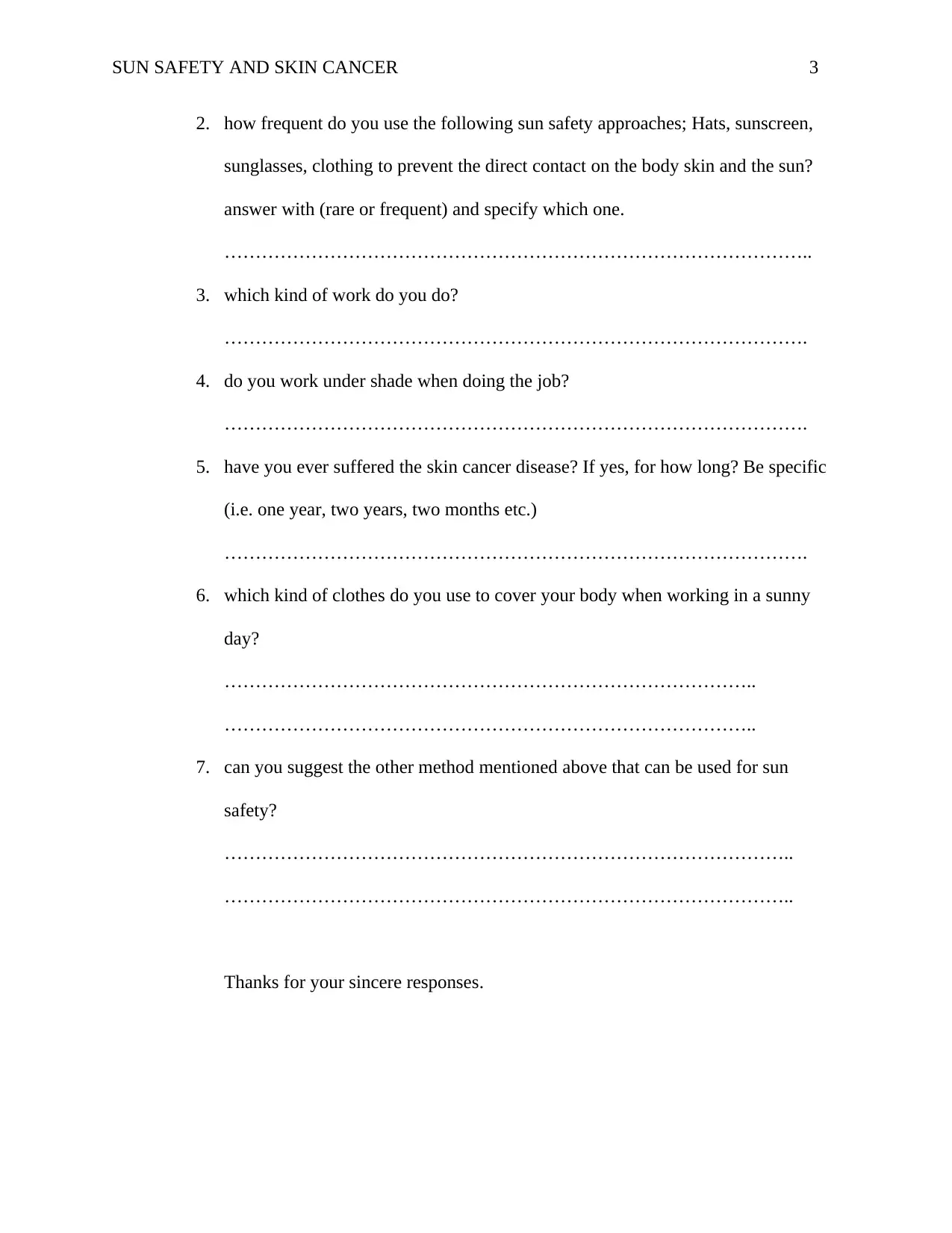
SUN SAFETY AND SKIN CANCER 3
2. how frequent do you use the following sun safety approaches; Hats, sunscreen,
sunglasses, clothing to prevent the direct contact on the body skin and the sun?
answer with (rare or frequent) and specify which one.
…………………………………………………………………………………..
3. which kind of work do you do?
………………………………………………………………………………….
4. do you work under shade when doing the job?
………………………………………………………………………………….
5. have you ever suffered the skin cancer disease? If yes, for how long? Be specific
(i.e. one year, two years, two months etc.)
………………………………………………………………………………….
6. which kind of clothes do you use to cover your body when working in a sunny
day?
…………………………………………………………………………..
…………………………………………………………………………..
7. can you suggest the other method mentioned above that can be used for sun
safety?
………………………………………………………………………………..
………………………………………………………………………………..
Thanks for your sincere responses.
2. how frequent do you use the following sun safety approaches; Hats, sunscreen,
sunglasses, clothing to prevent the direct contact on the body skin and the sun?
answer with (rare or frequent) and specify which one.
…………………………………………………………………………………..
3. which kind of work do you do?
………………………………………………………………………………….
4. do you work under shade when doing the job?
………………………………………………………………………………….
5. have you ever suffered the skin cancer disease? If yes, for how long? Be specific
(i.e. one year, two years, two months etc.)
………………………………………………………………………………….
6. which kind of clothes do you use to cover your body when working in a sunny
day?
…………………………………………………………………………..
…………………………………………………………………………..
7. can you suggest the other method mentioned above that can be used for sun
safety?
………………………………………………………………………………..
………………………………………………………………………………..
Thanks for your sincere responses.
⊘ This is a preview!⊘
Do you want full access?
Subscribe today to unlock all pages.

Trusted by 1+ million students worldwide
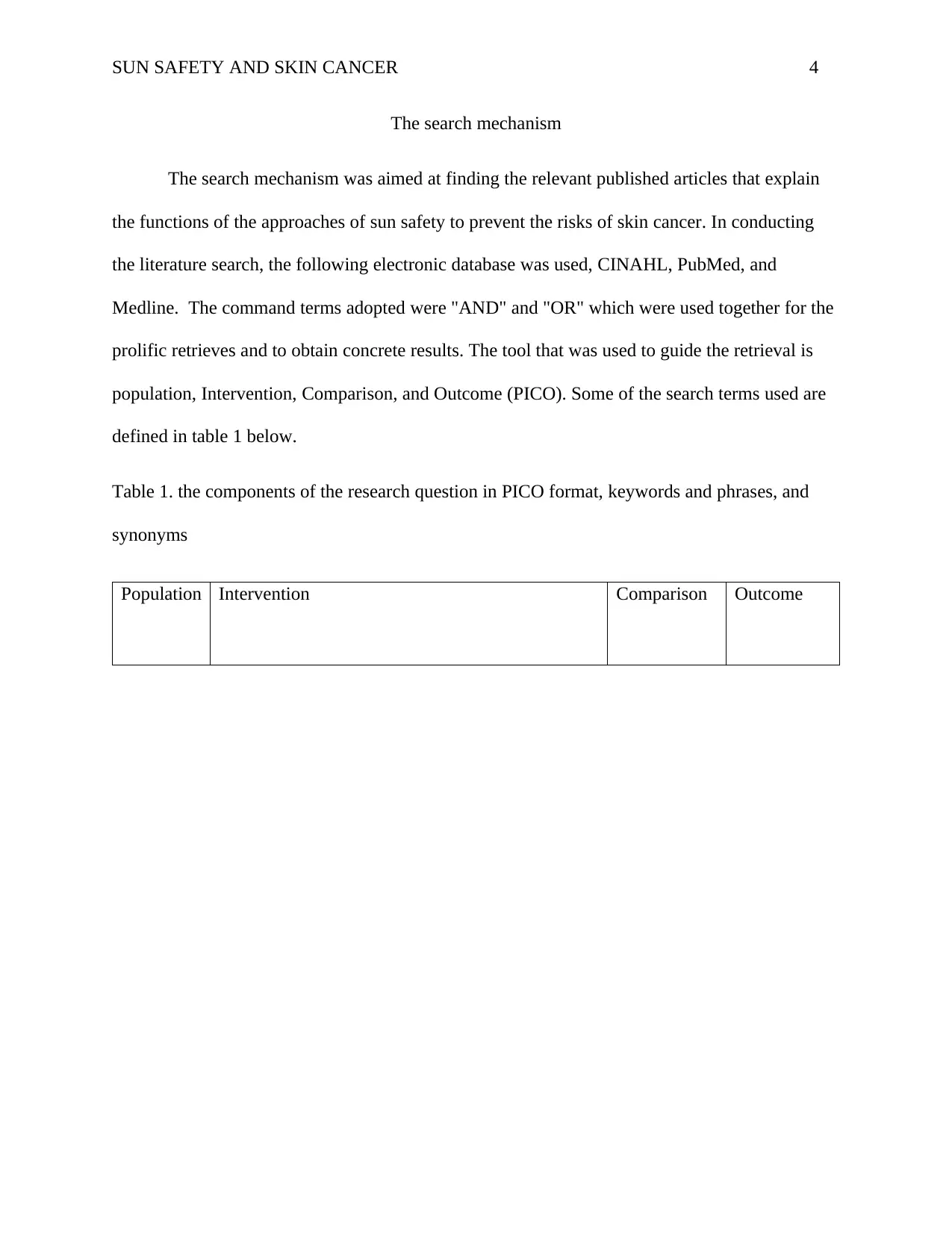
SUN SAFETY AND SKIN CANCER 4
The search mechanism
The search mechanism was aimed at finding the relevant published articles that explain
the functions of the approaches of sun safety to prevent the risks of skin cancer. In conducting
the literature search, the following electronic database was used, CINAHL, PubMed, and
Medline. The command terms adopted were "AND" and "OR" which were used together for the
prolific retrieves and to obtain concrete results. The tool that was used to guide the retrieval is
population, Intervention, Comparison, and Outcome (PICO). Some of the search terms used are
defined in table 1 below.
Table 1. the components of the research question in PICO format, keywords and phrases, and
synonyms
Population Intervention Comparison Outcome
The search mechanism
The search mechanism was aimed at finding the relevant published articles that explain
the functions of the approaches of sun safety to prevent the risks of skin cancer. In conducting
the literature search, the following electronic database was used, CINAHL, PubMed, and
Medline. The command terms adopted were "AND" and "OR" which were used together for the
prolific retrieves and to obtain concrete results. The tool that was used to guide the retrieval is
population, Intervention, Comparison, and Outcome (PICO). Some of the search terms used are
defined in table 1 below.
Table 1. the components of the research question in PICO format, keywords and phrases, and
synonyms
Population Intervention Comparison Outcome
Paraphrase This Document
Need a fresh take? Get an instant paraphrase of this document with our AI Paraphraser

SUN SAFETY AND SKIN CANCER 5
Australian
adults
aged
between
25
and 35
years
•
Australian
adults
• Young
adults
Frequent utilization of
Sun safety approaches
• Sunscreen
• Sunglasses
• Shade
• Clothing
• Hats
No
preventive
Strategy
•
Discretionary
or lack of use
of sunscreen,
hats, shade,
clothing, &
sunglasses
Skin cancer
Skin cancer
•
Keratinocyte
cancer
• Basal cell
carcinoma
• Cutaneous
squamous
cell
carcinoma
Database Search term Search yield Selected
articles
Pubmed Young adults AND sun safety OR sun prevention
strategies
AND skin cancer AND Australia, sun prevention
and skin
cancer OR Keratinocyte cancer or Basal cell
carcinoma OR
N =
120
4
Australian
adults
aged
between
25
and 35
years
•
Australian
adults
• Young
adults
Frequent utilization of
Sun safety approaches
• Sunscreen
• Sunglasses
• Shade
• Clothing
• Hats
No
preventive
Strategy
•
Discretionary
or lack of use
of sunscreen,
hats, shade,
clothing, &
sunglasses
Skin cancer
Skin cancer
•
Keratinocyte
cancer
• Basal cell
carcinoma
• Cutaneous
squamous
cell
carcinoma
Database Search term Search yield Selected
articles
Pubmed Young adults AND sun safety OR sun prevention
strategies
AND skin cancer AND Australia, sun prevention
and skin
cancer OR Keratinocyte cancer or Basal cell
carcinoma OR
N =
120
4
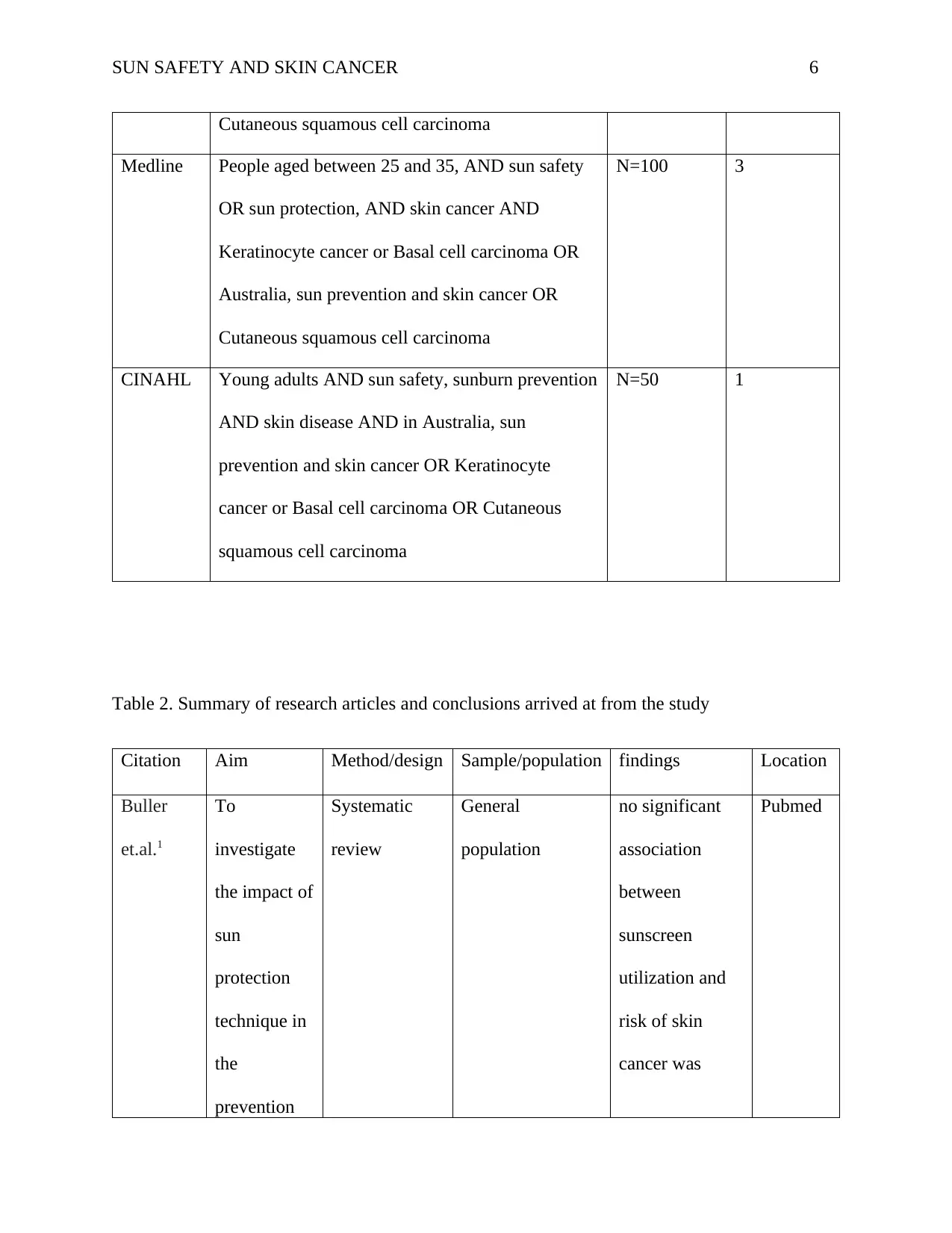
SUN SAFETY AND SKIN CANCER 6
Cutaneous squamous cell carcinoma
Medline People aged between 25 and 35, AND sun safety
OR sun protection, AND skin cancer AND
Keratinocyte cancer or Basal cell carcinoma OR
Australia, sun prevention and skin cancer OR
Cutaneous squamous cell carcinoma
N=100 3
CINAHL Young adults AND sun safety, sunburn prevention
AND skin disease AND in Australia, sun
prevention and skin cancer OR Keratinocyte
cancer or Basal cell carcinoma OR Cutaneous
squamous cell carcinoma
N=50 1
Table 2. Summary of research articles and conclusions arrived at from the study
Citation Aim Method/design Sample/population findings Location
Buller
et.al.1
To
investigate
the impact of
sun
protection
technique in
the
prevention
Systematic
review
General
population
no significant
association
between
sunscreen
utilization and
risk of skin
cancer was
Pubmed
Cutaneous squamous cell carcinoma
Medline People aged between 25 and 35, AND sun safety
OR sun protection, AND skin cancer AND
Keratinocyte cancer or Basal cell carcinoma OR
Australia, sun prevention and skin cancer OR
Cutaneous squamous cell carcinoma
N=100 3
CINAHL Young adults AND sun safety, sunburn prevention
AND skin disease AND in Australia, sun
prevention and skin cancer OR Keratinocyte
cancer or Basal cell carcinoma OR Cutaneous
squamous cell carcinoma
N=50 1
Table 2. Summary of research articles and conclusions arrived at from the study
Citation Aim Method/design Sample/population findings Location
Buller
et.al.1
To
investigate
the impact of
sun
protection
technique in
the
prevention
Systematic
review
General
population
no significant
association
between
sunscreen
utilization and
risk of skin
cancer was
Pubmed
⊘ This is a preview!⊘
Do you want full access?
Subscribe today to unlock all pages.

Trusted by 1+ million students worldwide
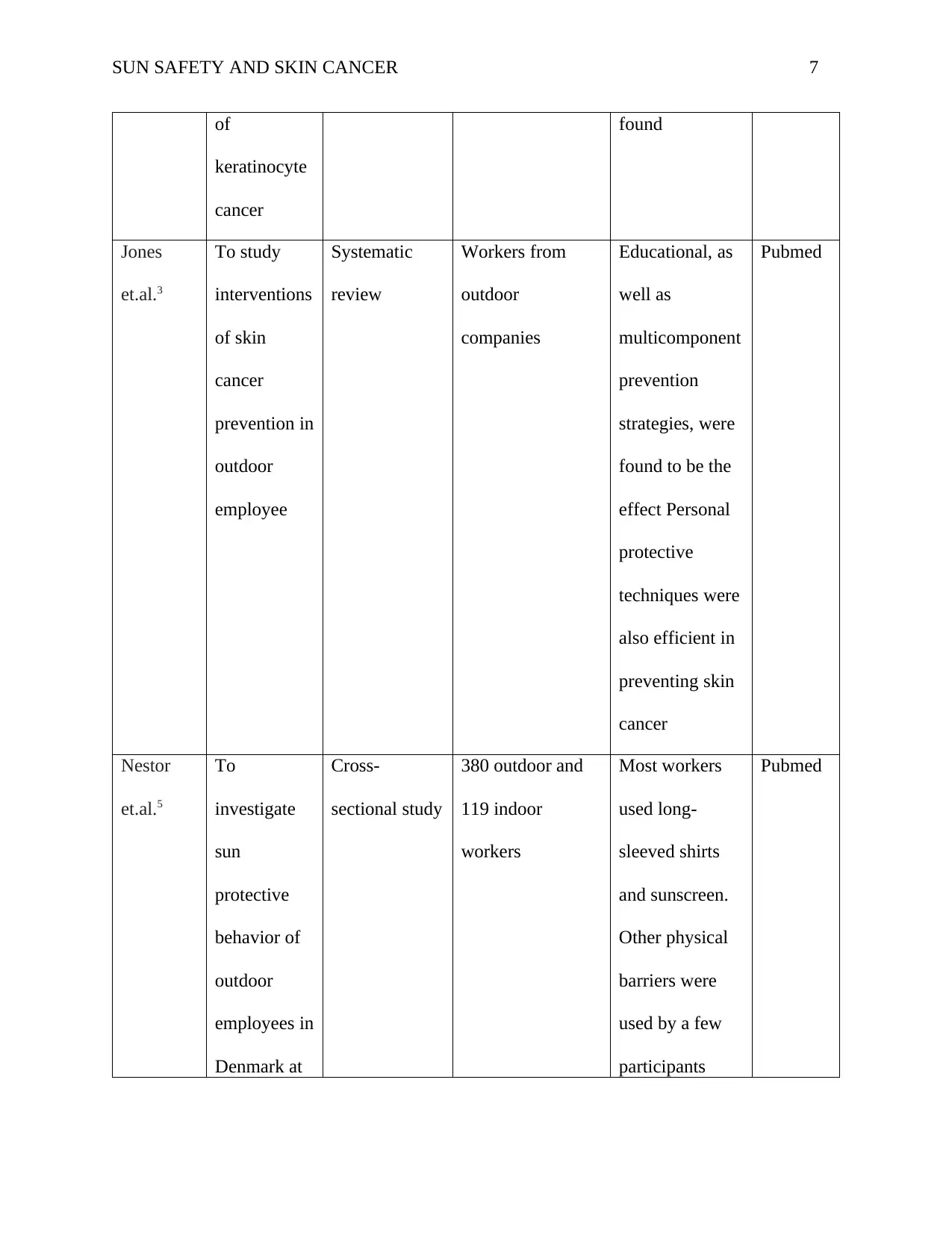
SUN SAFETY AND SKIN CANCER 7
of
keratinocyte
cancer
found
Jones
et.al.3
To study
interventions
of skin
cancer
prevention in
outdoor
employee
Systematic
review
Workers from
outdoor
companies
Educational, as
well as
multicomponent
prevention
strategies, were
found to be the
effect Personal
protective
techniques were
also efficient in
preventing skin
cancer
Pubmed
Nestor
et.al.5
To
investigate
sun
protective
behavior of
outdoor
employees in
Denmark at
Cross-
sectional study
380 outdoor and
119 indoor
workers
Most workers
used long-
sleeved shirts
and sunscreen.
Other physical
barriers were
used by a few
participants
Pubmed
of
keratinocyte
cancer
found
Jones
et.al.3
To study
interventions
of skin
cancer
prevention in
outdoor
employee
Systematic
review
Workers from
outdoor
companies
Educational, as
well as
multicomponent
prevention
strategies, were
found to be the
effect Personal
protective
techniques were
also efficient in
preventing skin
cancer
Pubmed
Nestor
et.al.5
To
investigate
sun
protective
behavior of
outdoor
employees in
Denmark at
Cross-
sectional study
380 outdoor and
119 indoor
workers
Most workers
used long-
sleeved shirts
and sunscreen.
Other physical
barriers were
used by a few
participants
Pubmed
Paraphrase This Document
Need a fresh take? Get an instant paraphrase of this document with our AI Paraphraser
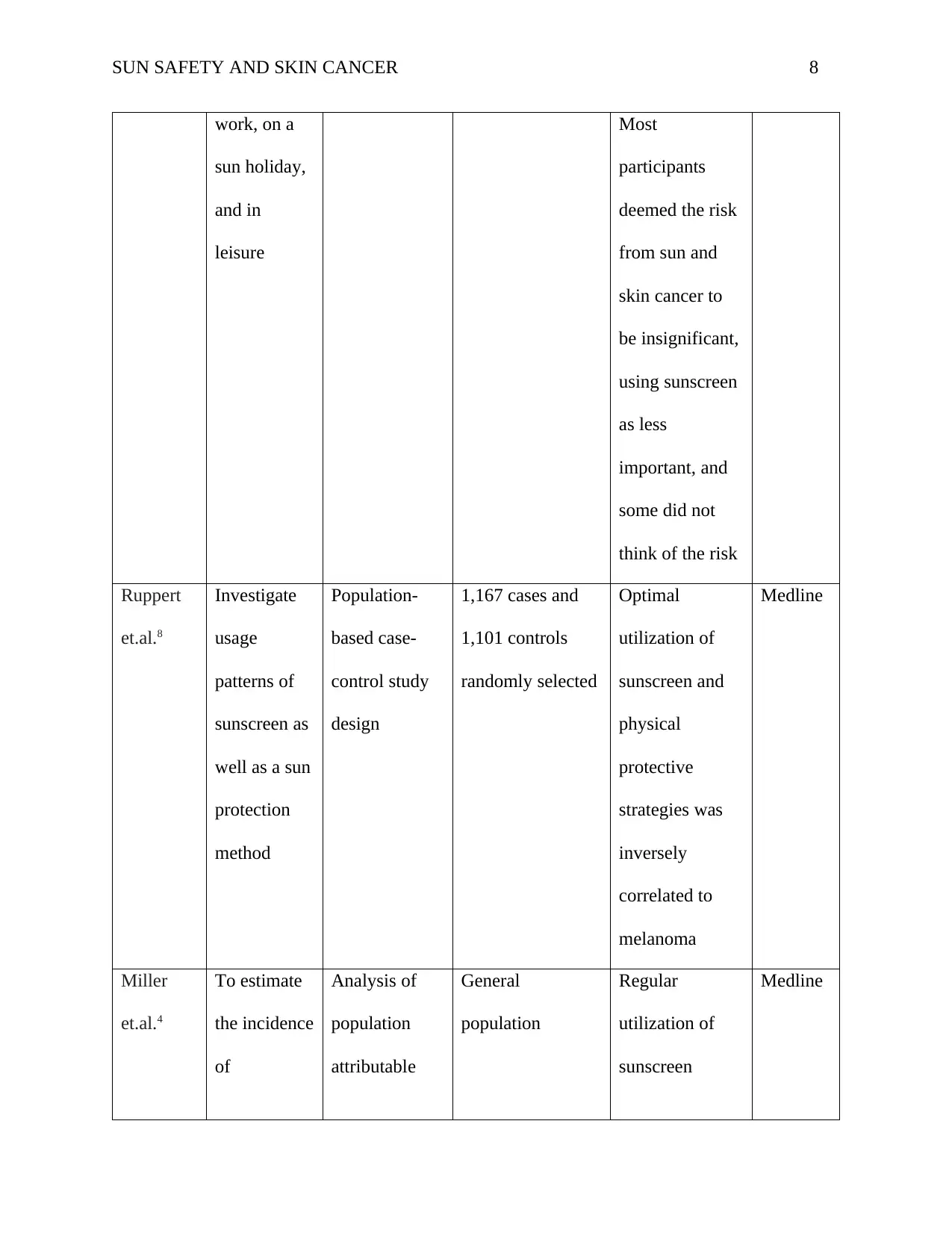
SUN SAFETY AND SKIN CANCER 8
work, on a
sun holiday,
and in
leisure
Most
participants
deemed the risk
from sun and
skin cancer to
be insignificant,
using sunscreen
as less
important, and
some did not
think of the risk
Ruppert
et.al.8
Investigate
usage
patterns of
sunscreen as
well as a sun
protection
method
Population-
based case-
control study
design
1,167 cases and
1,101 controls
randomly selected
Optimal
utilization of
sunscreen and
physical
protective
strategies was
inversely
correlated to
melanoma
Medline
Miller
et.al.4
To estimate
the incidence
of
Analysis of
population
attributable
General
population
Regular
utilization of
sunscreen
Medline
work, on a
sun holiday,
and in
leisure
Most
participants
deemed the risk
from sun and
skin cancer to
be insignificant,
using sunscreen
as less
important, and
some did not
think of the risk
Ruppert
et.al.8
Investigate
usage
patterns of
sunscreen as
well as a sun
protection
method
Population-
based case-
control study
design
1,167 cases and
1,101 controls
randomly selected
Optimal
utilization of
sunscreen and
physical
protective
strategies was
inversely
correlated to
melanoma
Medline
Miller
et.al.4
To estimate
the incidence
of
Analysis of
population
attributable
General
population
Regular
utilization of
sunscreen
Medline
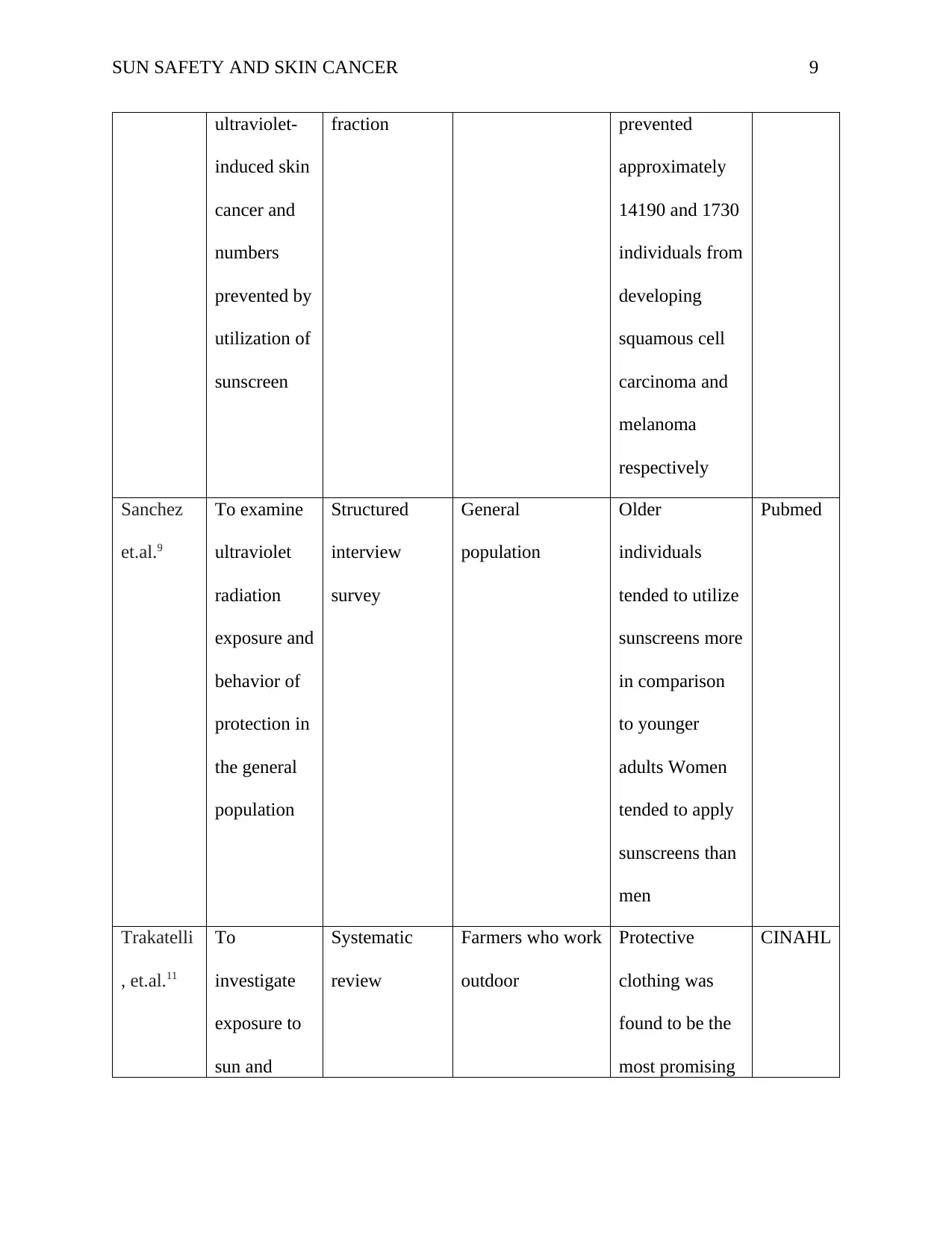
SUN SAFETY AND SKIN CANCER 9
ultraviolet-
induced skin
cancer and
numbers
prevented by
utilization of
sunscreen
fraction prevented
approximately
14190 and 1730
individuals from
developing
squamous cell
carcinoma and
melanoma
respectively
Sanchez
et.al.9
To examine
ultraviolet
radiation
exposure and
behavior of
protection in
the general
population
Structured
interview
survey
General
population
Older
individuals
tended to utilize
sunscreens more
in comparison
to younger
adults Women
tended to apply
sunscreens than
men
Pubmed
Trakatelli
, et.al.11
To
investigate
exposure to
sun and
Systematic
review
Farmers who work
outdoor
Protective
clothing was
found to be the
most promising
CINAHL
ultraviolet-
induced skin
cancer and
numbers
prevented by
utilization of
sunscreen
fraction prevented
approximately
14190 and 1730
individuals from
developing
squamous cell
carcinoma and
melanoma
respectively
Sanchez
et.al.9
To examine
ultraviolet
radiation
exposure and
behavior of
protection in
the general
population
Structured
interview
survey
General
population
Older
individuals
tended to utilize
sunscreens more
in comparison
to younger
adults Women
tended to apply
sunscreens than
men
Pubmed
Trakatelli
, et.al.11
To
investigate
exposure to
sun and
Systematic
review
Farmers who work
outdoor
Protective
clothing was
found to be the
most promising
CINAHL
⊘ This is a preview!⊘
Do you want full access?
Subscribe today to unlock all pages.

Trusted by 1+ million students worldwide

SUN SAFETY AND SKIN CANCER 10
strategies of
skin
protection in
agricultural
workers
avenue for
farmers in
comparison to
sunscreen and
other physical
barriers
Perera
et.al.6
To
investigate
the
prevalence
of self-
reported
behaviors
associated
with sun
safety
To identify
attitudes,
motivations,
and clinical
correlates of
sun safety
behaviors
Online survey
data from self-
reports
8178 international
participants in 10
different
languages
Utilization of
physical barriers
was strongly
linked to the
risk of skin
cancer than
sunscreen
Medline
strategies of
skin
protection in
agricultural
workers
avenue for
farmers in
comparison to
sunscreen and
other physical
barriers
Perera
et.al.6
To
investigate
the
prevalence
of self-
reported
behaviors
associated
with sun
safety
To identify
attitudes,
motivations,
and clinical
correlates of
sun safety
behaviors
Online survey
data from self-
reports
8178 international
participants in 10
different
languages
Utilization of
physical barriers
was strongly
linked to the
risk of skin
cancer than
sunscreen
Medline
Paraphrase This Document
Need a fresh take? Get an instant paraphrase of this document with our AI Paraphraser

SUN SAFETY AND SKIN CANCER 11
Literature Review.
Introduction
It has been revealed that skin disease is highly prevalent in Australia. This is due to
environmental degradation that leads to the prolonged summer season when the sun heat is
hotter, which leads to depletion of the ozone layer. The ultra-violet radiation during the summer
seasons is useful since they destroy the protective skin layers and tissues leading to skin cancer.
Direct sun effect can be minimized by developing the mechanisms of sun safety which can be
categorized into two namely; using physical barriers such as the wearing protective clothes, hats
and staying in the shades when the sun is hot or using the sunscreens methods.
The procedural analysis was conducted to investigate the sun safety behavior emulated by
children and how this behavior can improvise the skin cancer attack in their olden days. Buller
et.al.1 claimed that to curb the vast spread of skin cancer diseases. Extensive studies need to be
done with regards the mechanisms earlier mentioned so that an effective solution can be adopted
to help control and treat the skin cancer diseases between people of the age 25-35 years of age.
The research should not involve children, adolescent, and adults of age past 35 years.
Qualitative, quantitative, and mixed method peer-reviewed articles that had been published in the
olden days to hold on the current evidence of quality.
Sunscreen and skin cancer.
Since many people think that they are invincible and that they are not vulnerable to
contacting the skin cancer disease, this is just a theory that cannot be proven. Studies have
demonstrated that most people under the attack of skin disease did not get it due to a direct hit
from the sun rays. The inadequate protection from the direct sun rays is what causes skin cancer
Literature Review.
Introduction
It has been revealed that skin disease is highly prevalent in Australia. This is due to
environmental degradation that leads to the prolonged summer season when the sun heat is
hotter, which leads to depletion of the ozone layer. The ultra-violet radiation during the summer
seasons is useful since they destroy the protective skin layers and tissues leading to skin cancer.
Direct sun effect can be minimized by developing the mechanisms of sun safety which can be
categorized into two namely; using physical barriers such as the wearing protective clothes, hats
and staying in the shades when the sun is hot or using the sunscreens methods.
The procedural analysis was conducted to investigate the sun safety behavior emulated by
children and how this behavior can improvise the skin cancer attack in their olden days. Buller
et.al.1 claimed that to curb the vast spread of skin cancer diseases. Extensive studies need to be
done with regards the mechanisms earlier mentioned so that an effective solution can be adopted
to help control and treat the skin cancer diseases between people of the age 25-35 years of age.
The research should not involve children, adolescent, and adults of age past 35 years.
Qualitative, quantitative, and mixed method peer-reviewed articles that had been published in the
olden days to hold on the current evidence of quality.
Sunscreen and skin cancer.
Since many people think that they are invincible and that they are not vulnerable to
contacting the skin cancer disease, this is just a theory that cannot be proven. Studies have
demonstrated that most people under the attack of skin disease did not get it due to a direct hit
from the sun rays. The inadequate protection from the direct sun rays is what causes skin cancer
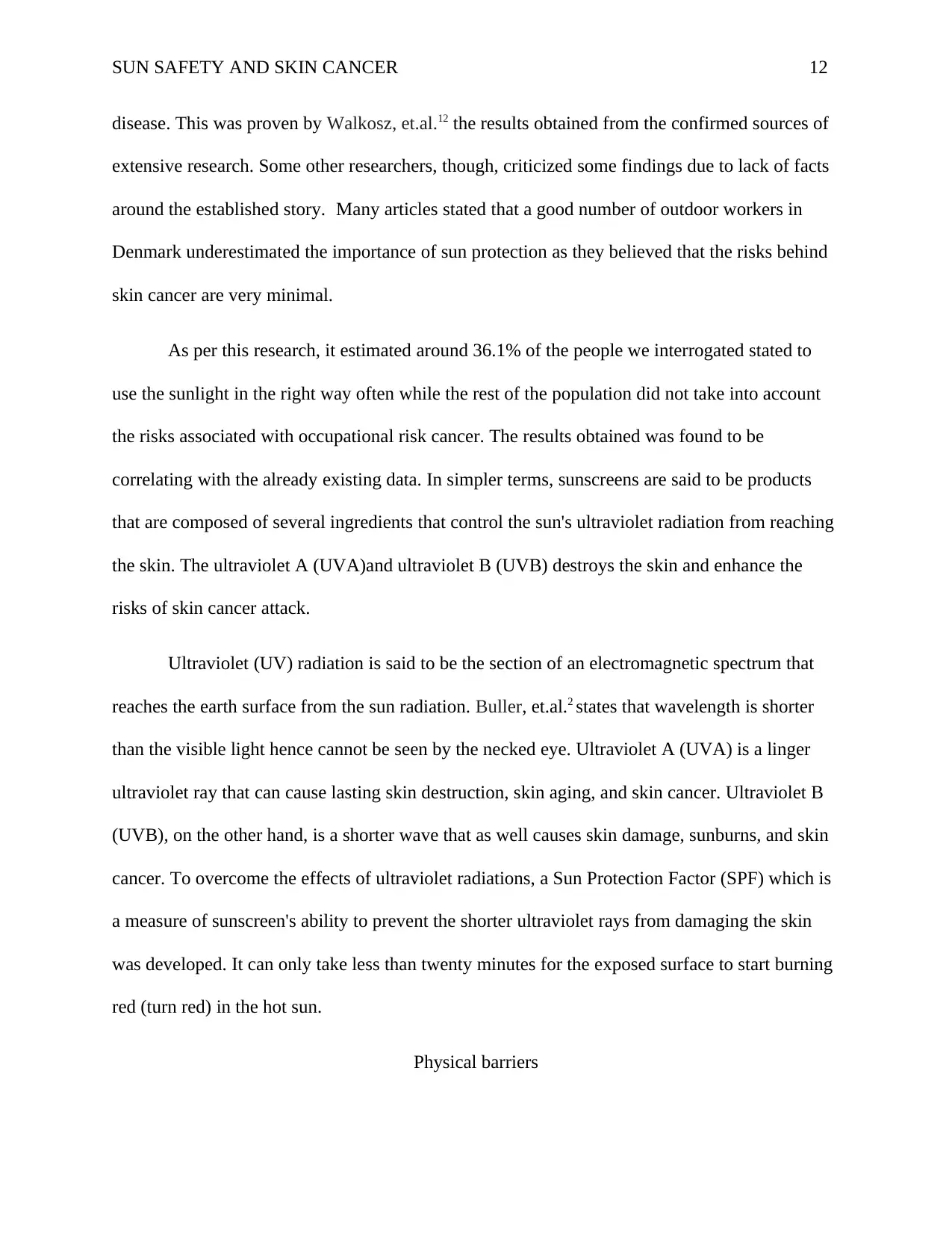
SUN SAFETY AND SKIN CANCER 12
disease. This was proven by Walkosz, et.al.12 the results obtained from the confirmed sources of
extensive research. Some other researchers, though, criticized some findings due to lack of facts
around the established story. Many articles stated that a good number of outdoor workers in
Denmark underestimated the importance of sun protection as they believed that the risks behind
skin cancer are very minimal.
As per this research, it estimated around 36.1% of the people we interrogated stated to
use the sunlight in the right way often while the rest of the population did not take into account
the risks associated with occupational risk cancer. The results obtained was found to be
correlating with the already existing data. In simpler terms, sunscreens are said to be products
that are composed of several ingredients that control the sun's ultraviolet radiation from reaching
the skin. The ultraviolet A (UVA)and ultraviolet B (UVB) destroys the skin and enhance the
risks of skin cancer attack.
Ultraviolet (UV) radiation is said to be the section of an electromagnetic spectrum that
reaches the earth surface from the sun radiation. Buller, et.al.2 states that wavelength is shorter
than the visible light hence cannot be seen by the necked eye. Ultraviolet A (UVA) is a linger
ultraviolet ray that can cause lasting skin destruction, skin aging, and skin cancer. Ultraviolet B
(UVB), on the other hand, is a shorter wave that as well causes skin damage, sunburns, and skin
cancer. To overcome the effects of ultraviolet radiations, a Sun Protection Factor (SPF) which is
a measure of sunscreen's ability to prevent the shorter ultraviolet rays from damaging the skin
was developed. It can only take less than twenty minutes for the exposed surface to start burning
red (turn red) in the hot sun.
Physical barriers
disease. This was proven by Walkosz, et.al.12 the results obtained from the confirmed sources of
extensive research. Some other researchers, though, criticized some findings due to lack of facts
around the established story. Many articles stated that a good number of outdoor workers in
Denmark underestimated the importance of sun protection as they believed that the risks behind
skin cancer are very minimal.
As per this research, it estimated around 36.1% of the people we interrogated stated to
use the sunlight in the right way often while the rest of the population did not take into account
the risks associated with occupational risk cancer. The results obtained was found to be
correlating with the already existing data. In simpler terms, sunscreens are said to be products
that are composed of several ingredients that control the sun's ultraviolet radiation from reaching
the skin. The ultraviolet A (UVA)and ultraviolet B (UVB) destroys the skin and enhance the
risks of skin cancer attack.
Ultraviolet (UV) radiation is said to be the section of an electromagnetic spectrum that
reaches the earth surface from the sun radiation. Buller, et.al.2 states that wavelength is shorter
than the visible light hence cannot be seen by the necked eye. Ultraviolet A (UVA) is a linger
ultraviolet ray that can cause lasting skin destruction, skin aging, and skin cancer. Ultraviolet B
(UVB), on the other hand, is a shorter wave that as well causes skin damage, sunburns, and skin
cancer. To overcome the effects of ultraviolet radiations, a Sun Protection Factor (SPF) which is
a measure of sunscreen's ability to prevent the shorter ultraviolet rays from damaging the skin
was developed. It can only take less than twenty minutes for the exposed surface to start burning
red (turn red) in the hot sun.
Physical barriers
⊘ This is a preview!⊘
Do you want full access?
Subscribe today to unlock all pages.

Trusted by 1+ million students worldwide
1 out of 19
Related Documents
Your All-in-One AI-Powered Toolkit for Academic Success.
+13062052269
info@desklib.com
Available 24*7 on WhatsApp / Email
![[object Object]](/_next/static/media/star-bottom.7253800d.svg)
Unlock your academic potential
Copyright © 2020–2025 A2Z Services. All Rights Reserved. Developed and managed by ZUCOL.





